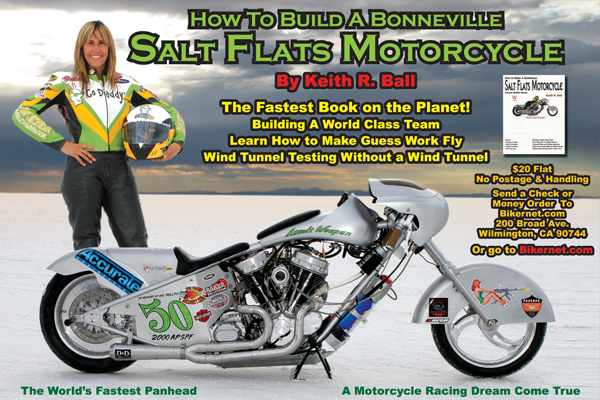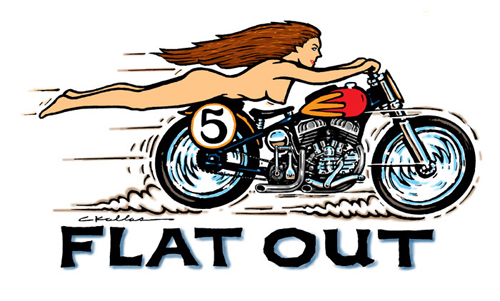

In this chapter we’re taking all the plans, boiling them in oil and spinning them into action—no bullshit. The frame is underway, as you will witness. The wheels are in hand. The transmission was delivered and the Avon Tyres were shipped today.
The notions and input keep flying my way via e-mail and phone calls, but let’s jump right into the middle of the action, beginning with Rick Krost, who is building our Assalt Weapan frame, at U.S. Choppers:

Seriously, I need to get engine dimensions first. Also would like to know centerline numbers from engine shaft to tranny shaft if you have a primary and clutch pack picked out. If it's all production stuff–that’s fine, but realize that some guys produce their primary with the wrong measurements making the belt too tight, which in turn makes for a shitty clutch and near impossible starts……so just because they have a big name still doesn't mean their products work!!
If we have a primary in hand, I can use it when building the frame for real numbers, so we don't experience binding in the drive-train (we use BDL and have never had a problem). Remember, if Berry, Accurate Engineering, does his job perfectly, as I assume he will, then we can lose all of his talent through the primary/clutch set-up. If you have those numbers, I can start getting my drawings together and start frame building.
Also front and rear tires will vary from 23.5 to 28 inches depending on the side-wall heights and rim sizes – 23.5 for 16-inch rims to 28-inch for 21-inch rims…. plus or minus the side-wall and tread differences….. this is a 5-inch disparity that we must make provisions for! I believe Chris Kallas (official 5-Ball racing illustrator) has both wheels at 26 inches, if I am reading the drawing correctly. This would most likely mean a 18-inch rim in back and front with 4 tall side-walls and tread. If we are at 26 inches then the axle center would be 13 inches off of the ground as Chris illustrates.
To make our measurements linear, then of course, the same would apply for the front tire measurements to make the frame level to the ground as the drawing illustrates……(so I believe we should have our tires and wheels first, in order to make measurements for the frame and front end). This would assure we don't run into any problems with regards to having 3 inches of ground clearance from front to rear and we can make accurate assumptions for front end length and trail calculations.
Get this, if you make a perfect structure and set it on an imperfect surface, all of those measurements were for not. Thus like a tailor fitting a suit, we must have a starting point.
My thought is that the starting point should be the axle heights and if we are to nail down those, then we need an accurate measurement of the entire front and rear wheel diameters with the correct Z rated Avon tires mounted and aired up to real air pressures……..
Just a thought, but keep in mind, I'm just a simpleton with a wheel cage that moves about 3 rpms…… so take it for what it's worth.
Also we need to dial in that trail measurement better than “zero” as Chris stated earlier. That would really make me nervous!! I know Leo is our man for that, as he has a lot of potential with the Girder style set-up and it's infinite adjustability. However, I feel like he can do his job better and easier if he has a neck height from me and some “real” axle references as stated before. He can then figure his leg length, calculate for trail/rake and any “sag” on the front end.
Getting really excited about this project- lets get these numbers nailed down and get rocking!
–Rick
U.S. Choppers
2039 S. Lyon St
Santa Ana, CA 92705
714-546-4699
Appointments Only Please

After we received Rick’s e-mail we informed him that we generally use only BDL primary drives and never had a problem with their configurations for Softails or FXRS. We researched our wheel diameters for Chris Kallas and Rick through Avon Tyres. Our wheels with tires mounted should be 24.6 front and 25.8 in the rear.
We now have the All American Wheels cut by Renegade in hand and the Tires are on their way to us. I will have them mounted and deliverd to U.S. Choppers A.S.A.P.

NICK ROBERTS, 5-BALL SPONSOR SPEAKS UP FOR NICK’S PERFORMANCE AND AMSOIL OILS–Great update…I like where you're going with this and I only have a couple of thoughts that I'd like to toss in.
First a question…why is a headlight included in the concept drawings? Is there a requirement that you have a headlight? I would think this area would respond to a more aerodynamic form such as a cover over the steering head and trees and may eliminate a lot of potential turbulence and drag. When I look at the concept drawings my other thought regarding aerodynamics is that the exposed engine is going to cause all sorts of turbulence.We must run an open front end and can drop the headlight in our class, but we need to push the air out around the front of the bike. Unfortunately V-Rod headlights don’t cut it—only allowed on V-Rods. Regarding the open engine we hope to use the pipes and air cleaner to guide the air. Plus, we need some air through the engine for cooling on the hot salt.
Secondly….Thinking back to the Trials it seems like almost all the bikes with fairings, (streamlining), covered their engines. I appreciate the aesthetics of the exposed Panhead engine but I wonder if it wouldn't make more sense to design a fairing around the engine to channel the air needed for cooling while smoothing the airflow around the bike and Valerie. Just thought I'd throw that out for you to consider while you are still in the design phase of the project.
We are running in the open bike class. No fairing allowed.
Several years ago I was in Jerry Bickel's shop where he builds Pro-Stock drag cars. Jerry had an interesting analogy for thinking about the effects of airflow and ways to cheat the wind. He thinks of air as a fluid that he has to manage in order to slice his way through it on the way down the track. He stressed that the biggest problem he faced was the air clinging to the car and hence creating more drag.
There’s an interesting anomaly involved in cutting air. This is our golf ball theory. It was discovered years ago that smooth golf balls wouldn’t travel as far as the dinged brothers. I was told that air gathers on a surface and creates a Tephlon like coating which allows additional air to glide over it effortlessly. Hence a coarse finish is more beneficial that a slick polished one.
Jerry came up with some ingenious ways to add velocity generators to the rear quarter panel in order to break the air's hold on the body. In the case of his cars the rule book didn't allow anything like velocity generators; so in true racer fashion he came up with the idea to modify the stickers on the quarter panel which created the desired turbulence and broke the air's drag; allowing his car to gain few extra seconds advantage. The tech guys searched his car at several events before they discovered his innovation and banned it. Any mention of velocity generators in the rule book? My point here is that there are a number of ways to cheat the wind, and lessen the attendant frictional drag, that don't require major modification to the overall design.
We’ll look into VGs.
N.R.H.S , nrhsperformance.com, in Boulder, Colorado went 217 mph on a Buell at the Speed Trials and they may have some insights they are willing to share. Their bike has quite a bit of streamlining as well as the fact that they are experienced with Land Speed Racing having been involved for several years. You might want to give Daniel Dunn at N.R.H.S. a call and get his thoughts about the effects of aerodynamics on the bike at 200+ mph. His number is 303-833-4500 and email is Daniel@nrhsperformance.com.
Thanks Nick, I’ll do that.


THE NITROUS CONSIDERATION– Don't know if you are goin this way for power (200 MPH Club). If you are, is to be “carbinated” or “Infected”??? Multiple stages might be a real good idea. Forget about “Dry Nitrous.” Daytona Twin Tec has good EFI systems. V-Thunder has a simple module for a carbinated system with Nitrous. One thing I saw on the bike was that front shot with Val on it. Adios those handle bars!! Get something goin low and close to the fork tubes. A girder made from aircraft tubing would be real bitchin. Air-Tech makes good aero body work stuff. Have you thought about changing your exhaust at all??? Also looking at the pictures of the engine do your oil returns in the left case side dump onto the flywheels??? –PabloWe are running with Pegasus EFI from BDL and the pipes are scheduled to be built by Berry Wardlaw of Accurate engineering and Larry Curik from Lone Star Choppers.–Bandit 



LET’S STEP BACK IN TIME FOR A BONNEVILLE LEGEND–The following photos and copy about the 1949 Vincent Black Lightning – Supercharged, are from the Solvang Museum site (pashnit.com)
This is one of only 30 Black Lightnings ever made and was the first one in the USA. This bike held the 1-mile world speed record (unsupercharged) in 1953 and then held the American record of 182 mph supercharged. This is probably the meanest pre-1950 bike you will ever see. This bike is located in the Solvang, California Auto Museum.

On a cool Monday morning on Sept. 13, 1948, Rollie Free lifted from Harley- Davidson the US national motorcycle speed record by riding the first Vincent HRD Black Lightning racing motorcycle to a speed of 150.313 m.p.h. When Rollie's leathers tore from early runs at 147 mph, he discarded them and made a final, heroic attempt without jacket, pants, gloves, boots or helmet.
Aboard the motorcycle owned by the California sportsman, John Edgar, this final run resulted in the most famous photograph in motorcycling, the “bathing suit bike” shot taken from a speeding car on the Bonneville Salt Flats in Utah. Rollie lay flat out on the motorcycle wearing only a speedo bathing suit, shower cap and a pair of borrowed sneakers.


The AMA certified Free's record. Special features included the first-ever Vincent use of a rear shock absorber, the first Mk II racing cams and horizontally mounted racing carbs.

BONNEBELLE SIDEBAR–This bike is also coming together for Bonneville 2007. It’s a 45 flathead with a K-model top end being rebuilt and hopped-up by Departure Bike Works in Richmond, Virginia.

We are waiting on a set of original 45 flathead pistons, which Ross Pistons will turn into higher compression K-Model pistons with the Ross touch. They should arrive this week.


HEADGEAR RECOMMENDATIONS FROM A BIKERNET READER–I've written the few of you that I thought might appreciate quality racing gear. Tee Hee.

I'm not sure if it's SNELL approved, but I think I found the perfect helmet for use at Bonneville.Can you imagine showing up at tech. inspection….Let's see, Boots, Gloves, Leathers,….Whoa..what the F*ck is That!
–Drew Gatewood

Meanwhile back at the U.S. Choppers playground the frame began to take shape. “The kids were cranky and of course, as all youngsters are, lacking many things for us to finish,” Rick said. “No 5/8-inch tap in the whole shop! This stopped the rear end fixture we needed to make to produce a frame this length. No front motor mounts etc….. next Saturday.




Aces handled U.S. Choppers first run of Street Platform frames and we have become friends since. Both Marcio and Luke are good guys who deliver what they promise. “Their sense of humor is a bit strange, though, and I really feel they should get out more,” said Rick. “Four of us worked on a Saturday to see this Bonneville bike come to fruition. Rick, Marcio, Luke, and Lunger (our machinist friend who is suffering from some serious flu type symptoms). He had to operate the machinery without medicine for safety sake.” The four musketeers will join again for their next epic battle (next Saturday)- stay tuned!

CONCEPTS FOR SPEED FROM JOEL PEVEY– No offense, but Chris Kallas' last drawing was a bit scary — it is his best 'to-scale' drawing yet, but 2 feet over length? – see drop tube angle – motor can be positioned much farther fwd, with legs more towards the vertical, but we'll need to review rider position and using ballast in more detail later.
Again no offense – his latest is already an improvement on last year and will be workable if that is what you have decided on already.It’s not 2 feet over. Actually it will be stretched 6 to the rear and 8 to the front.
Rick Krost had mentioned possibility of going with a dual downtube, a two-leg frame. Might want to take him up on that. Dual top tube also, at least from center post back?? Will explain why later. Can also get sketches to you – too bad I can't draw for shit, but I'll do the best I can.

GET WITH BERRY ON FINAL DIMENSIONS OF MOTOR. I know you gave Rick the dimensions of last year's motor, but didn't Berry say this “ONE OFF” will be very different? The engine dimensions determine EVERYTHING else. Engine 1st, VT20 second.That was handled by Berry directly with Rick, Admiral.
WHEN ARE YOU FLYING VT20 (Valerie Thompson, our Go-Daddy Rider) out for fitting to frame? That is our first real HARD TARGET DATE.- Any other dates or schedule known? Test dates at El Mirage, for example? Just asking.
However, would YOU like to tech the bike and take it for a couple runs the day before VT20 shows up? When it comes to feedback on handling, balance, controls, etc. There is nothing like first hand experience. PLUS, it would make for great Bikernet content!!! What the hell – get Bates or Vanson to donate a set of leathers with Bikernet and 5-Ball Racing graphics all over them, and go for it!!

Our plan is to have Valerie fly out in about three weeks for our initial fitment and moulding party. We’re going to cover her in foam and push her around the block. Hang on for that.–Bandit

UPDATED FRAME DIMENSIONS FROM CHRIS KALLAS–Here's a crack at modifying the fork angle. I cut-n-pasted the wheel back towhere you'd have about 3.75 inches of trail. Guessing the fork angle at about 32 degrees.Wheel base comes to approx. 81 inches instead of 85. Depending where your at withRick and Leo's progress this could be a moot point, plus this is based on mypreliminary frame dimensions. May still be a glimpse of what it might look like.
–C. Kallas

LEO’S RESPONSE TO THE NEW DRAWING– This will work into the plan perfectly. What we have been heading toward, will now come to life by adjusting my relations of upper and lower control arm length to each other thru the eccentric in the control arms then moving the shock so the control arms run parallel to the earth I will build more trail and get wheel closer to the power-plant of the bike to decrease the size of the perpendicular thru-air pockets effectively making it more like a streamliner as we have been discussing . Good work. I'm still working on the note from my mom.
–Leo DiOrio

